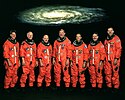STS-103
 | |
| Dane misji | |
| Indeks COSPAR | 1999-069A |
|---|---|
| Zaangażowani | |
| Oznaczenie kodowe | STS-103 |
| Pojazd | |
| Wahadłowiec | |
| Załoga | |
 Od lewej: Michael Foale, Claude Nicollier, Scott Kelly, Curtis Brown, Jean-Francois Clervoy, John Grunsfeld i Steven Smith. | |
| Dowódca | |
| Start | |
| Miejsce startu | |
| Początek misji | 20 grudnia 1999 00:50:00 UTC |
| Orbita okołoziemska | |
| Apogeum | 609 km |
| Perygeum | 563 km |
| Okres orbitalny | 96,4 min |
| Inklinacja orbity | 28,45° |
| Lądowanie | |
| Miejsce lądowania | KSC, pas startowy 33 |
| Lądowanie | 28 grudnia 1999 00:00:47 UTC[1] |
| Czas trwania misji | |
| Przebyta odległość | 5,23 mln km[2] |
| Liczba okrążeń Ziemi | 119[2] |
| Program lotów wahadłowców | |
STS-103 – trzecia (SM3A) misja serwisowa amerykańskiego wahadłowca Discovery do Kosmicznego Teleskopu Hubble’a. Równocześnie był to dwudziesty siódmy lot promu kosmicznego Discovery i dziewięćdziesiąty szósty programu lotów wahadłowców[3].
Załoga
- źródło[3]
- Curtis Brown (6)*, dowódca
- Scott J. Kelly (1), pilot
- Steven Smith (3), specjalista misji 1
- Michael Foale (5), specjalista misji 4
- John M. Grunsfeld (3), specjalista misji 3
- Claude Nicollier (4), specjalista misji 5 (ESA, Szwajcaria)
- Jean-François Clervoy (3), specjalista misji 2 (ESA, Francja)
- *(w nawiasie podano liczbę lotów odbytych przez każdego z astronautów)
Parametry misji
- Masa:
- startowa orbitera: 112 493 kg
- lądującego orbitera: 95 768 kg
- Perygeum: 563 km[4]
- Apogeum: 609 km[4]
- Inklinacja: 28,45°[4]
- Okres orbitalny: 96,4 min[4]
Cel misji
- źródło[3]
- Trzeci lot serwisowy do Kosmicznego Teleskopu Hubble’a, umieszczonego na orbicie w kwietniu 1990 roku (Discovery STS-31).
Trzecia misja serwisowa została podzielona na dwa etapy, tworząc SM3A i SM3B (Servicing Mission). 13 listopada 1999 roku awarii uległ już czwarty spośród sześciu żyroskopów satelity, co uniemożliwiło sterowanie położeniem teleskopu. SM3A miała za zadanie przywrócenie sprawności Hubble’a. W czasie misji wymieniono wszystkie żyroskopy, a także komputer pokładowy i dokonano kilku innych istotnych napraw. Wyłączono Kamery Bliskiej Podczerwieni i Spektrometru Multiobiektowego (NICMOS) do czasu instalacji systemu chłodzenia (podczas następnej misji serwisowej)[5].
Spacer kosmiczny
- źródło[3]
- EVA -1 (22 grudnia 1999, 8 godz. 15 min): S. Smith, J. Grunsfeld.
- EVA-2 (23 grudnia 1999, 8 godz. 10 min): M. Foale, C. Nicollier.
- EVA-3 (24 grudnia 1999, 8 godz. 8 min): S. Smith, J. Grunsfeld.
Zobacz też
Przypisy
- ↑ a b Adam Chen, William Wallack, George Gonzales: Celebrating 30 Years of the Space Shuttle program. NASA, 2012. ISBN 978-0-16-090202-4.
- ↑ a b c podsumowanie misji STS-103 na stronie KSC (ang.)
- ↑ a b c d Tomáš Přibyl: Dzień, w którym nie wróciła COLUMBIA. Bielsko-Biała: Wydawnictwo >DEBIT<, s. 174. ISBN 83-7167-224-1.
- ↑ a b c d Mark Wade: STS-103 (ang.). W: Encyclopedia Astronautica [on-line]. [dostęp 2017-07-27].
- ↑ Steve Whitfield: Hubble. Kosmiczny teleskop. Warszawa: Prószyński Media Sp. z o.o., s. 18-19, seria: Historia podboju Kosmosu. ISBN 978-83-7648-999-5.
Linki zewnętrzne
- podsumowanie misji STS-103 na stronie KSC (ang.)
- Mark Wade: STS-103 (ang.). W: Encyclopedia Astronautica [on-line]. [dostęp 2017-07-27].
- Spaceflight mission report: STS-103 (ang.). Spacefacts. [dostęp 2017-07-27].
Media użyte na tej stronie
The flag of Navassa Island is simply the United States flag. It does not have a "local" flag or "unofficial" flag; it is an uninhabited island. The version with a profile view was based on Flags of the World and as a fictional design has no status warranting a place on any Wiki. It was made up by a random person with no connection to the island, it has never flown on the island, and it has never received any sort of recognition or validation by any authority. The person quoted on that page has no authority to bestow a flag, "unofficial" or otherwise, on the island.
Designed by the crewmembers, the STS-103 emblem depicts the Space Shuttle Discovery approaching the Hubble Space Telescope (HST) prior to its capture and berthing. The purpose of the mission is to remove and replace some of the Telescope's older and out-of-date systems with newer, more reliable and more capable ones, and to make repairs to HST's exterior thermal insulation that has been damaged by more than nine years of exposure to the space environment. The horizontal and vertical lines centered on the Telescope symbolize the ability to reach and maintain a desired attitude in space, essential to the instrument's scientific operation. The preservation of this ability is one of the primary objectives of the mission. After the flight, the Telescope will resume its successful exploration of deep space and will continue to be used to study solar system objects, stars in the making, late phases of stellar evolution, galaxies and the early history of the universe. HST, as represented on this emblem was inspired by views from previous servicing missions, with its solar arrays illuminated by the Sun, providing a striking contrast with the blackness of space and the night side of Earth.
- The NASA insignia design for Shuttle flights is reserved for use by the astronauts and for other official use as the NASA Administrator may authorize. Public availability has been approved only in the form of illustrations by the various news media. When and if there is any change in this policy, which is not anticipated, it will be publicly announced.
These seven astronauts have been assigned as crew members for NASA's third servicing mission to the Hubble Space Telescope (HST). They are, from the left, astronauts C. Michael Foale, Claude Nicollier, Scott J. Kelly, Curtis L. Brown, Jr., Jean-Francois Clervoy, John M. Grunsfeld and Steven L. Smith. Brown and Kelly are commander and pilot, respectively. All the others are mission specialists (MS), with international MS Nicollier and Clervoy representing the European Space Agency (ESA).


